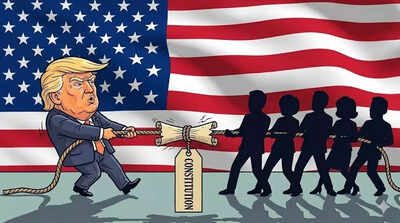American politics has seen angry words, wild speeches and theatrical showdowns, but a sitting president accusing lawmakers of behaviour “punishable by death” has jolted Washington in a way few statements do. A video released by six Democratic lawmakers urging US service members to reject unlawful orders has triggered President Donald Trump’s most explosive and punitive response since taking office.
What triggered the clash
Six Democratic lawmakers with military or intelligence backgrounds released a video reminding troops that they are legally allowed to disobey illegal or unconstitutional commands. Senator Mark Kelly, a former Navy captain and astronaut, says the law is clear that service members can refuse unlawful orders. The group argues that threats to the Constitution can come from inside the country and that the oath of service requires loyalty to the Constitution above everything else.The messaging was blunt, direct and framed as a constitutional safeguard.President Trump reacted with fury. He called the lawmakers “traitors”, described the video as “seditious behaviour at the highest level” and repeatedly suggested that such offences are “punishable by death”. He demanded their arrest, said an “example must be set” and amplified posts calling for the lawmakers to be hanged.
Why the reaction is so intense
For Trump and his allies, the video was interpreted as an attempt to undermine civilian control of the military by encouraging troops to question the legitimacy of presidential authority. The White House argued that telling 1.3 million service members to assess the legality of orders amounts to destabilising the chain of command.Republicans in Congress supported this reading, calling the Democrats’ video irresponsible and dangerous. They framed the president’s comments not as calls for execution but as a forceful description of potential legal consequences.Democrats, in turn, accused the president of issuing threats against elected officials. They argued that Trump’s rhetoric could endanger their safety at a moment when political tensions in the US are already high.
Why this matters
The United States military operates on strict hierarchy, civilian oversight and legal clarity. Any messaging that appears to challenge that hierarchy draws immediate scrutiny. But any suggestion that a president is invoking death penalties against political opponents raises even more fundamental alarms.The debate is unfolding in a country acutely sensitive to political violence. Recent years have seen attempted assassinations, arson attacks on political leaders’ homes and the killing of lawmakers. Trump himself has survived two assassination attempts. As a result, language about treason, sedition and punishment carries a far sharper edge than normal partisan rhetoric.
What the Democratic video actually said
The lawmakers did not tell troops to defy the president. They told them to refuse unlawful commands if they ever arise. This is rooted in longstanding military law and the principle that soldiers cannot be compelled to carry out illegal orders. The video frames this as a way of protecting the Constitution against internal threats.They emphasised that no amount of intimidation or political pressure will deter them from upholding their constitutional duty. Their tone was resolute, but within legal boundaries.
What happens next
The matter is being reviewed at the federal level. Congressional leaders are coordinating with security agencies to ensure the targeted lawmakers and their families are protected. The White House is trying to steady the political fallout without backing away from the president’s core argument that the Democrats crossed a legal line.It remains extremely unlikely that any sedition charges will arise. The threshold for such a charge is high and the lawmakers’ video falls well within political speech protected by law. But the clash has sharpened questions about how far political rhetoric can go when national security and civilian control of the military are involved.
The larger picture
At its core, the confrontation is about two competing ideas of loyalty. The Democratic message appeals to loyalty to the Constitution. The president’s response appeals to loyalty to the chain of command. Both ideas are foundational to American democracy. The clash between them is now playing out in the open.This episode also exposes the fragility of the moment. When routine constitutional reminders provoke talk of treason and death, it signals a political environment primed for escalation. In a country already anxious about violence and extremism, the tone of its leaders is not just rhetoric. It shapes public expectations and determines how combustible the months ahead may become. Go to Source



